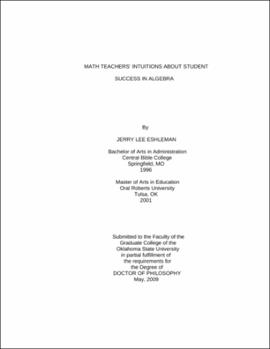| dc.contributor.advisor | Montgomery, Diane | |
| dc.contributor.author | Eshelman, Jerry Lee | |
| dc.date.accessioned | 2013-11-26T08:34:25Z | |
| dc.date.available | 2013-11-26T08:34:25Z | |
| dc.date.issued | 2009-05 | |
| dc.identifier.uri | https://hdl.handle.net/11244/7386 | |
| dc.description.abstract | Scope and Method of Study: The purpose of this research study was to determine the effectiveness of math teachers' judgments regarding a student's future achievement. Judgments were based on external observations or cues used as predictors of success. This study used Social Judgment Theory (SJT) to demonstrate a possible method for better understanding how teachers make decisions. For this study, the teachers made judgments in the form of predictions on the student's future performance in the Algebra I end-of-instruction assessment as used by the state of Oklahoma. The predictors or cues extracted from math education literature as relevant to student performance are gender, ethnicity, Grade Point Average (GPA), self-concept and socioeconomic status. | |
| dc.description.abstract | Findings and Conclusions: This study supports the proposition that teachers may have used intuitive decision-making to make predictions of student performance. This was evidenced by the reduced number of cues they relied upon. The findings revealed, as anticipated, out of the 5 possible cues, teachers used GPA as their primary means to base their prediction decision. However, because GPA was so heavily relied upon to make their decisions, it is unclear if they used intuitive or analytical means of decision-making. Although the reduction in the number of cues utilized may reveal intuitive thinking, another possible way of looking at this was that teachers relied upon a formula. This formula appears to emphasize the superiority of GPA as a predictor. Regardless of the means in which GPA was ultimately chosen, teachers attained statistically significant levels of accuracy. In addition, when compared to each other, teachers' decision strategies had a high degree of similarity. This study found following: teachers did not seem to use or need all possible cues provided, their use of decision-making was accurate and there was a significant degree of consistency among the teachers' decision policies or strategies. | |
| dc.format | application/pdf | |
| dc.language | en_US | |
| dc.rights | Copyright is held by the author who has granted the Oklahoma State University Library the non-exclusive right to share this material in its institutional repository. Contact Digital Library Services at lib-dls@okstate.edu or 405-744-9161 for the permission policy on the use, reproduction or distribution of this material. | |
| dc.title | Math teachers' intuitions about student success in algebra | |
| dc.contributor.committeeMember | Bull, Kay | |
| dc.contributor.committeeMember | Harrist, R. Steven | |
| dc.contributor.committeeMember | Miller, Janice | |
| osu.filename | Eshleman_okstate_0664D_10225 | |
| osu.accesstype | Open Access | |
| dc.type.genre | Dissertation | |
| dc.type.material | Text | |
| dc.subject.keywords | algebra | |
| dc.subject.keywords | decision | |
| dc.subject.keywords | intuition | |
| dc.subject.keywords | judgment | |
| dc.subject.keywords | predictions | |
| dc.subject.keywords | teachers | |
| thesis.degree.discipline | Teaching and Curriculum Leadership | |
| thesis.degree.grantor | Oklahoma State University | |
